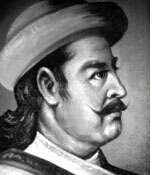Nain Singh Thapa
Nain Singh Thapa or Nayan Singh Thapa (Nepali: नैनसिंह थापा/नयनसिंह थापा) (died late 1806 or early 1807) was a Nepalese Kaji (minister) and a military general. He died in the offensive campaign of Kangra from bullet injury. He was the owner of the Thapathali Durbar temple complex.
Nain Singh Thapa | |
|---|---|
जनरल काजी नैनसिंह थापा | |
 Portrait of Thapa Kaji Nain Singh | |
| Personal details | |
| Born | 1777 AD Borlang, Gorkha district |
| Died | 1728 Saka Era (1806/07 AD) Kangra Fort, Garhwal Kingdom |
| Children | Mathabar Singh Thapa, Queen Tripurasundari of Nepal, Ujir Singh Thapa, Ganesh Kumari (mother of Jung Bahadur Rana) |
| Mother | Satyarupa Maya |
| Father | Amar Singh Thapa (sardar) |
| Relatives | Bhimsen Thapa (brother) Ranajit Pande (father-in-law) Balbhadra Kunwar (nephew) Jang Bahadur Rana (grandson) |
| Residence | Thapathali Durbar |
| Military service | |
| Allegiance | |
| Rank | General |
| Battles/wars | Battles of Unification of Nepal |
Family Tree
He was born as second son to Sanukaji Amar Singh Thapa.[1] Nayan Singh Thapa had 4 brothers - Bhimsen Thapa, Bhaktawar Singh, Amrit Singh and Ranbir Singh and two step-brothers - Ranzawar and Ranbam.[1] He was father of Mathabarsingh Thapa, Queen Tripurasundari of Nepal and grandfather of Jung Bahadur Rana.[2] He was the son-in-law of Chief Kazi Ranajit Pande of noble Pande family and father-in-law of Kazi Bal Narsingh Kunwar of the noble Kunwar Rana family.[3] Kumar Pradhan asserts that Sher Jung Thapa was son of Nain Singh Thapa, whom Bhimsen adopted[1] while Baburam Acharya contradicts that Sher Jung Thapa was nephew of Mathabarsingh Thapa and was sixteen years old on April 1835.[4]
| Nain Singh Thapa | Rana Kumari Pande | ||||||||||||||||||||||||||||||||||
| Ganesh Kumari* | Queen Tripurasundari of Nepal (born 1794) | Ujir Singh Thapa (born 1796) | Mathabarsingh Thapa (born 1798) | ||||||||||||||||||||||||||||||||
| Ranojjwal Singh Thapa | Bikram Singh Thapa | Amar Singh Thapa II | |||||||||||||||||||||||||||||||||
- Ganesh Kumari is mother of Jung Bahadur Rana, founder of Rana dynasty.[3]
Life as military officer

He was a Kaji and General of Nepal Army.[7] A royal order was decreed on Ashwin Sudi 2, 1862 V.S. (September 1805), for the preparations of Kangra campaign.[8] In September 1805, while being deputed at Kangra Fort, his brother Mukhtiyar Bhimsen Thapa ordered him to arrest military deserters.[9] Gorkhali forces under Badakaji Amar Singh Thapa, Rudrabir [Shah] and Nain Singh overran Nalagarh and crossed Sutlej river.[10] They fought battle against King Sansar Chand at Mahal Mori in May 1806[10] and defeated him there.[10][11] Sansar Chand fled to Kangra fort[11] after taking refuge at Sujanpur Tira.[10] Widow of Kirti Chand, Commander of Kangra Army and Nain Singh, the Nepalese commander led the battle at Tira Sujanpur.[12] The Gorkhali invasion became persistent and irresistible.[11] On Saturday V.S. 1863 Kartik Badi 13 (i.e. 8 November 1806), there was a letter which positioned Bhakti Thapa under the joint authority of Badakaji Amar Singh Thapa and Nain Singh.[13] Kaji Nain Singh came with a reinforcement of 1500 men along with Sardar Udatta Shahi leading 3 companies while Subba Ranganath Gurung and Prahlad Gurung had led 4 companies.[14] Nain Singh and Amar Singh were entrusted with the main Nain Singh fought at Kangra fort and was mortally wounded from which he died[15][16] in the winter of 1806/1807.[17] The Bhasavamshawali also states the death of Nain Singh on 1728 Saka Era i.e. (1806/7) A.D.[13] The event was sketched by 19th-century Garhwali poet and painter Mola Ram. In the 1852 interview, Jang Bahadur Rana mentioned the death of his maternal grandfather Nain Singh at Kangra.[17]
He was the owner of Thapathali Durbar.
Sources
- Pradhan, Kumar L. (2012), Thapa Politics in Nepal: With Special Reference to Bhim Sen Thapa, 1806–1839, New Delhi: Concept Publishing Company, p. 278, ISBN 9788180698132
- Acharya, Baburam (2012), Acharya, Shri Krishna (ed.), Janaral Bhimsen Thapa : Yinko Utthan Tatha Pattan (in Nepali), Kathmandu: Education Book House, p. 228, ISBN 9789937241748
- Regmi, Mahesh Chandra (1999). Imperial Gorkha: sn account of Gorkhali rule in Kumaun (1791-1814). Adroit Publications. ISBN 9788187392026.
- Whelpton, John (1991). Kings, soldiers, and priests: Nepalese politics and the rise of Jang Bahadur Rana, 1830-1857. Manohar Publications. p. 254. ISBN 9788185425641.
- Hamal, Lakshman B. (1995). Military history of Nepal. Sharda Pustak Mandir. p. 125. OCLC 32779233.
- Shaha, Rishikesh (1982). Essays in the Practice of Government in Nepal. Manohar. p. 44. OCLC 9302577.
- Datta, Chaman Lal (1997). The raj and the Simla Hill states: socio-economic problems, agrarian disturbances and paramountcy. ABS Publications. ISBN 9788170720720.
- Punjabi University (1988). Proceedings, Volume 21. Punjabi University.
- Lal, Prem Hari Har (1993). The Doon Valley Down the Ages. Dehradun, India: Interprint. ISBN 9788185017648.
- D.R. Regmi (1975). Modern Nepal vol.1. Firma KL Mukhopadhyay.
- Institute of Nepal and Asian Studies (1985). Contributions to Nepalese studies, Volumes 13-14. Institute of Nepal and Asian Studies, Tribhuvan University.
References
- Pradhan 2012, p. 23.
- Shaha 1982, p. 44.
- JBR, PurushottamShamsher (1990). Shree Teen Haruko Tathya Britanta (in Nepali). Bhotahity, Kathmandu: Vidarthi Pustak Bhandar. ISBN 99933-39-91-1.
- Acharya 2012, pp. 152-153.
- Acharya 2012.
- Pradhan 2012, p. 22-23.
- Hamal 1995, p. 125.
- Regmi 1999, p. 62.
- Regmi 1999, p. 75.
- Datta 1997, p. 5.
- Punjabi University 1988, p. 193.
- Lal 1993, p. 85.
- Institute of Nepal and Asian Studies 1985, p. 185.
- D.R. Regmi 1975, p. 199.
- Hamal 1995, p. 206.
- D.R. Regmi 1975, p. 203.
- Whelpton 1991, p. 254.